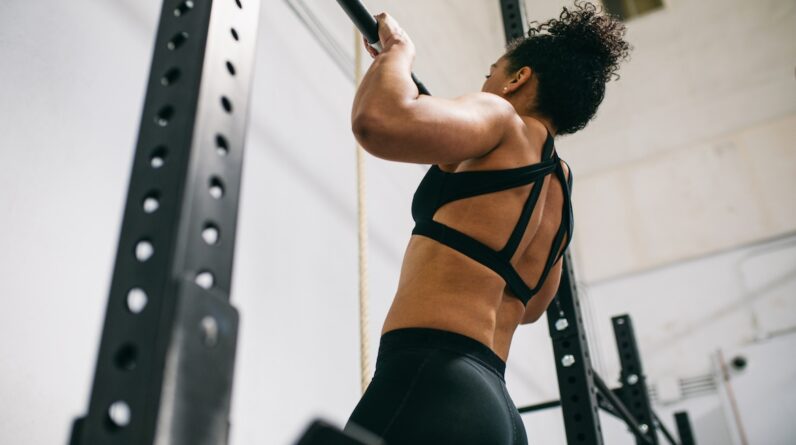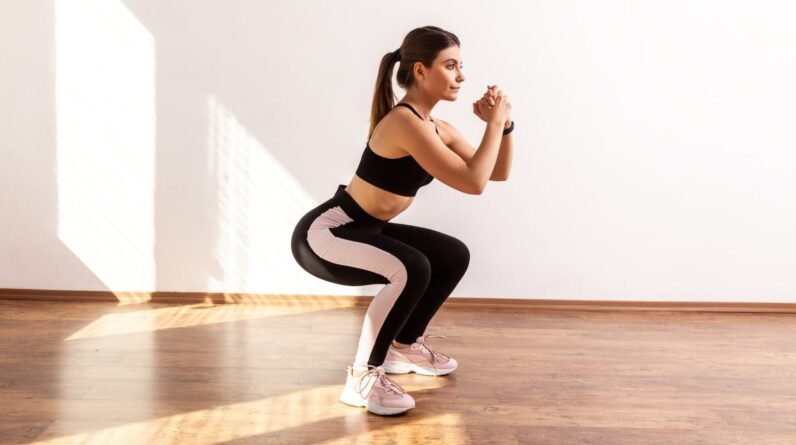
But lifting your entire body as you dangle from a bar is no easy task, which is why pull-ups can be, well, hella intimidating. Still, don’t shy away from the challenge—they’re infamously tough (and for good reason), but pull-ups are not impossible.
With commitment and consistency, you can achieve one rep, and then another. And another. Until you’re cranking out a whole set.
Whether you’re training for your first (or 20th) pull-up, read on to learn how to nail the move with perfect form, exactly which muscles pull-ups work, and all the bonuses they offer for your body (spoiler alert: there are a lot).
How to do a pull-up with perfect form every time
Like any exercise, you need proper form to make the pull-up effective and to reduce your risk of injury. Here’s how to perfect your pull-up technique.
- Hang from a bar with an overhand grip, hands shoulder-width apart or a little wider.
- Keep your shoulders back and down (imagine tucking your shoulder blades into your back pockets).
- Pull your chin toward the bar, focus on bringing your elbows down to toward your lats (instead of concentrating on getting your chin over the bar).
- Slowly lower yourself to the starting position.
Pull-ups: muscles worked
Part of the reason pull-ups are so tough? They target a ton of upper-body muscles.
The primary muscles are the lats (i.e., the latissimus dorsi, the largest muscle in your back known for its “V” shape) and the biceps, says Ben Lauder-Dykes, a NYC-based personal trainer, group fitness instructor, and run coach.
But pull-ups also work these muscles:
- Trapezius (another large muscle in your back that runs from the base of your neck, across your shoulders, and down to the middle of your back)
- Rhomboids (upper-back muscles that connect between your spine and your shoulder blades)
- Rear deltoids (muscles on the backside of the shoulders)
- Forearms (the group of muscles between your elbow and your wrist)
Who should and (shouldn’t) do pull-ups
Anyone looking to level up their fitness, build muscle, and improve functional strength should give pull-ups go (including gym newbies starting from scratch). Though a “good baseline upper-body strength” and healthy shoulders (read: no injuries) will give you a solid advantage, says Keri Anderson, a personal trainer at Life Time Plymouth in Minnesota.
On the other hand, pull-ups can be problematic for certain people, Anderson says. These groups include:
- People with shoulder impingements
- People with severe joint issues
- People with insufficient baseline strength
If you fall into any of these categories, you might want to avoid or modify pull-ups (more on this later) to prevent potential injury.
7 benefits of pull-ups
“Pull-ups offer a multitude of benefits, making them an essential exercise in any fitness routine,” Anderson says. Here are a few:
1. Stronger back and arms
Want to develop a strong, muscular back and well-defined arms? Pull-ups are a great way to build upper-body strength as they’re a “comprehensive upper-body workout,” Anderson says.
“In order to build muscle, we want to take muscles through greater ranges of motion, and the pull-up is arguably one of the greatest ranges of motion for the lats and biceps,” Lauder-Dykes says. “More importantly, [it] places the biggest effort/stress on those muscles in their lengthened/stretched position.” This is where the real muscle growth happens.
2. Better shoulder health
While “pull-ups primarily target the latissimus dorsi, the large muscles in your back,” they also engage the shoulder muscles “by working the stabilizing muscles around the shoulder joint,” Anderson says. In doing so, “they promote better shoulder health,” she says.
Strong shoulders are key if you’re trying to prevent shoulder pain, especially as you age. Even if your shoulders feel OK now, shoulder weakness can creep up on you when you spend a lot of time sitting (read: slumped in front of a screen). Shoulder pain is incredibly common (more than 2 million Americans see their provider for it every year, per the Cleveland Clinic), so adding pull-ups to your upper-body days might be a smart strategy as far as pain prevention.
3. Stronger core
Not only can pull-ups give you a sculpted back and arms, but they can also help you get a strong core too.
“While performing pull-ups, the core muscles are activated to stabilize the body,” Anderson says. “This engagement strengthens the abdominal muscles and helps in developing a solid core, essential for overall body strength and stability.”
Keep in mind, though, pull-ups won’t work your midsection the same way that core-focused exercises do, Lauder-Dykes says. Think of the ab-activation as more of an added bonus, not the main benefit.
4. Improved grip strength
“Your grip is obviously important in a pull up [you’re hanging from a bar, after all] and is challenged during the movement,” Lauder-Dykes says.
Anderson agrees: “The act of hanging from the bar and pulling your body weight up significantly enhances grip strength,” i.e., the amount of force applied when you clench your hand around something. A strong grip is a great thing to have, “not only for other exercises but also for daily activities requiring a firm grip,” she says. Think about it: You can’t open a pickle jar without good grip strength.
What’s more, grip strength is a pretty accurate predictor of overall health (and even longevity), according to the Cleveland Clinic. It’s true: People with stronger grips tend to live longer.
5. More relative strength
A lot of gymgoers focus on maximal, or absolute, strength, i.e., the type of strength it takes to move a heavy object (like the heaviest weight you can lift for one rep). But relative strength (the strength you have to move your body, aka how strong someone is compared to their size) “is just as important for overall fitness,” Lauder-Dykes says.
“Pull-ups are an excellent way to increase relative strength, as they require lifting one’s body weight,” Anderson says. “This is particularly important as it enhances functional fitness, making everyday tasks easier and improving overall athletic performance.”
On top of that, “improving relative strength is often safer, more accessible, and can be performed more frequently to allow for more consistent progress,” Lauder-Dykes adds.
6. Improved posture
Hunched over a computer most of the day? Yep, us too. If your posture is taking a hit from too much sitting, pull-ups are your friend. “Pull-ups also improve posture by strengthening the upper-back muscles, which can help counteract the effects of prolonged sitting,” Anderson says.
7. Minimal equipment required
You don’t need an expensive gym membership or any fancy fitness gear to do a pull-up. All it takes is you and a sturdy bar of some sort. “You can really do this exercise anywhere, anytime, as long as you can find something to hold onto,” Lauder-Dykes says.
“You can really do this exercise anywhere, anytime, as long as you can find something to hold onto.” —Ben Lauder-Dykes
Anderson agrees: “This makes it an accessible exercise that can be performed almost anywhere, whether at the gym, at home, or in a park.” Talk about convenient.
4 common mistakes when doing pull-ups
Whether you’re new to pull-ups or an old pro, it can be easy to form bad habits. But poor technique can negate all the body bonuses, maybe even lead to injury over time, and actually change the ideal muscles worked when doing pull-ups. Avoid these common mistakes the next time you’re up at the bar.
1. Letting your arm muscles do all the work
“This happens when the elbows move too far forward at the start of the pull up, making it harder to use the powerful lat muscles,” Lauder-Dykes says. Without your lats, it’ll be even tougher getting your chin above the bar, he says,
“You can correct this by using a band to practice the movement pattern,” Lauder-Dykes says. Or you can try cluster reps. This involves doing 1 to 2 reps, resting for 10 to 15 seconds, and repeating 3 to 4 times (to complete 6 to 8 reps total). “This helps to avoid compensating as you get fatigued so you can keep the quality of the reps high during the whole set,” he says.
2. Using momentum (kipping)
A lot of people tend to fall into a trap of kipping, Anderson says. This happens when you rock or swing your body (or kick yourself up) toward the bar. But when you use momentum, you’re not using muscle. This means you won’t build as much strength.
Look, we get it. Pull-ups are no joke. But don’t cheat yourself out of the benefits by kipping. To avoid this, do fewer reps at a time (to fight off fatigue and the urge to use momentum) and consciously focus on controlled movement.
Still kipping? Use modifications (more on this in a bit) to help you build the baseline strength in your upper body.
3. Not going through the full range of motion
Avoiding full extension is another common mistake, Anderson says. Again, fatigue is often to blame. When you get tired, you might sacrifice range of motion to get more reps. But, remember, the best way to build your lats and biceps is by taking these muscles through greater ranges of motion.
So if you find yourself shortening your pull-ups (i.e., you don’t lower yourself all the way to the bottom), listen to your body. It might be time to take a break. Fewer quality reps (over quantity) is always better.
4. Flaring your elbows
If your elbows spread out to the sides like chicken wings, you won’t maximize your lats or generate enough force to pull efficiently. The trick: Keep your elbows tucked at your sides, slightly forward and under the bar, Anderson says.
Modifications for pull-ups
Real talk: Pull-ups are hard AF. Even the strongest people struggle to crank out more than a couple at a time. For most of us, pull-ups take time to master.
Before you can be a badass at the bar, you might need to modify the movement or do pull-up alternatives to meet your current fitness or strength level. These modifications will help you grow muscle and upper-body strength. Plus, they allow you to focus on practicing good form.
“Gradually [you can] build up to full pull-ups by increasing the difficulty of these modifications,” Anderson says. Trust us, in no time, you’ll be banging out a bunch of pull-ups at the bar.
1. Use an assistive device
A little helpful equipment can go a long way when it comes to nailing the perfect pull-up. Here are a few types of gear to use to up your pull-up game:
Resistance band: You can “modify pull-ups by using resistance bands for assistance,” Anderson says. This method decreases the amount of bodyweight you have to heave up to the bar on your own.
The set-up is super easy: Simply wrap the band over the bar and loop it in itself, then pull it down and place your foot inside the band.
Smith machine: “My favorite way to modify the pull is to use a Smith machine,” Lauder-Dykes says.
Also known as inverted rows or Australian pull-ups, Smith machine pull-ups are performed parallel to the ground (you do it under the bar in a horizontal pull position with your feet on the floor).
This position helps “reduce the amount of body weight you are pulling on each rep,” Lauder-Dykes says. Because you don’t have to pull all your bodyweight, it’s slightly less strenuous. But’s it’s still super challenging and a great way to strengthen your biceps and back muscles. “Keeping your feet on the ground allows you to create more stability and focus on building your upper body strength,” he says.
To do it:
- Lay horizontally under the Smith machine bar (or any stable bar, say, a secure a barbell on a squat rack).
- Grab the bar using an overhand grip with hands shoulder-width apart.
- Brace your core and pull your chest toward the bar, squeezing your shoulder blades together.
- Keep your body in a straight line, then lower back down.
“You always want to make sure your hips are off of the floor when your arms are fully extended,” Lauder-Dykes says. “You can make it more challenging by increasing the height of the bar,” he adds.
Lifting straps: Notice that your grip gives out sooner than your other muscles during pull-ups? “You may need to get some lifting straps so that you train the lats and biceps closer to failure without your grip giving out,” Lauder-Dykes says. “Your grip strength will still improve using lifting straps, but it will make a big difference to your progress with the pull-up,” he says.
Gymnastic rings or a suspension trainer: Sometimes the thing standing between you and the perfect pull-up is the right grip. Along with lifting straps, you can also support your grip by using rings or suspension trainers. This allows you to experiment with or “vary grip positions” to find the best option for you, Anderson says.
2. Try negative pull-ups
Breaking the pull-up down into parts can be helpful too. Case in point: negative pull-ups. This involves starting at the top of the bar and “slowly lowering yourself” down until your arms are fully extended, Anderson says. Once this variation feels good, you can move up to the next level of difficulty (think: a pull-up with a resistance band for support).
3. Do alternatives instead
If you’re still struggling with pull-up modifications (no shame in that), your body’s trying to tell you something. Take a moment to assess. You might need to work on foundational strength first.
“If someone is not physically strong enough to do any variation of a bodyweight pull-up, it would be more effective for them to find an exercise to build up their strength,” Lauder-Dykes says.
These exercises will help you grow stronger muscles in your arms and back and prep you for pull-ups. Try adding them to your push-pull workouts:
From here, you can start progressing toward more challenging movements, and, eventually, the standard pull-up, Lauder-Dykes says.
FAQ
Do pull-ups actually build muscle?
Hell yeah. “Pull-ups primarily target the latissimus dorsi, the large muscles in your back, while also engaging the biceps, triceps, and shoulder muscles,” Anderson says. “This comprehensive upper-body workout helps in developing a strong, muscular back and well-defined arms.”
What are the disadvantages of pull-ups?
Because pull-ups require significant upper-body strength, beginners might find them too challenging. Heck, folks of all fitness levels may struggle to master the notoriously difficult exercise.
What’s more, pull-ups can also put stress on your shoulders, especially if you have weakness or instability in this area. In other words, you can easily injure yourself.
If you ever feel pain or discomfort when doing pull-ups, press pause. Your body’s telling you that something’s up. While your muscles may shake (due to exertion), no exercise should ever hurt.
How many pull-ups per day?
While relative strength varies, the average person can “aim for 25 to 50 per week, which you can break down either per day or across two to three sessions,” Lauder-Dykes says.
See how that feels, then adjust “the volume and frequency based on your fitness level and recovery capacity,” Anderson says.
Think you can handle more? Advanced gym enthusiasts can “aim for 3 to 4 sets of pull-ups, 8 to 12 reps per set, 2 to 3 times per week,” she says. Even if you can’t hit the target right now, keep working on it. Consistency is key to success.
Why am I strong but can’t do pull-ups?
That’s the million-dollar question. But the answer is pretty straightforward. Pull-ups require strength in so many areas: upper body, core, and grip. If one is lacking, pull-ups will be nearly impossible.
On top of this, you need serious relative strength to achieve a pull-up. While you might have a lot of absolute (maximal) strength, many people struggle with relative strength. “Relative strength refers to the strength-to-weight ratio of an individual,” Anderson says.
Essentially, it’s a measure of how easily you can lug your own weight around. It’s why bodyweight exercises like pull-ups (and push-ups) are so challenging. And why larger people with big muscles (for example, pro bodybuilders) may have trouble getting their chin above the bar as well.







